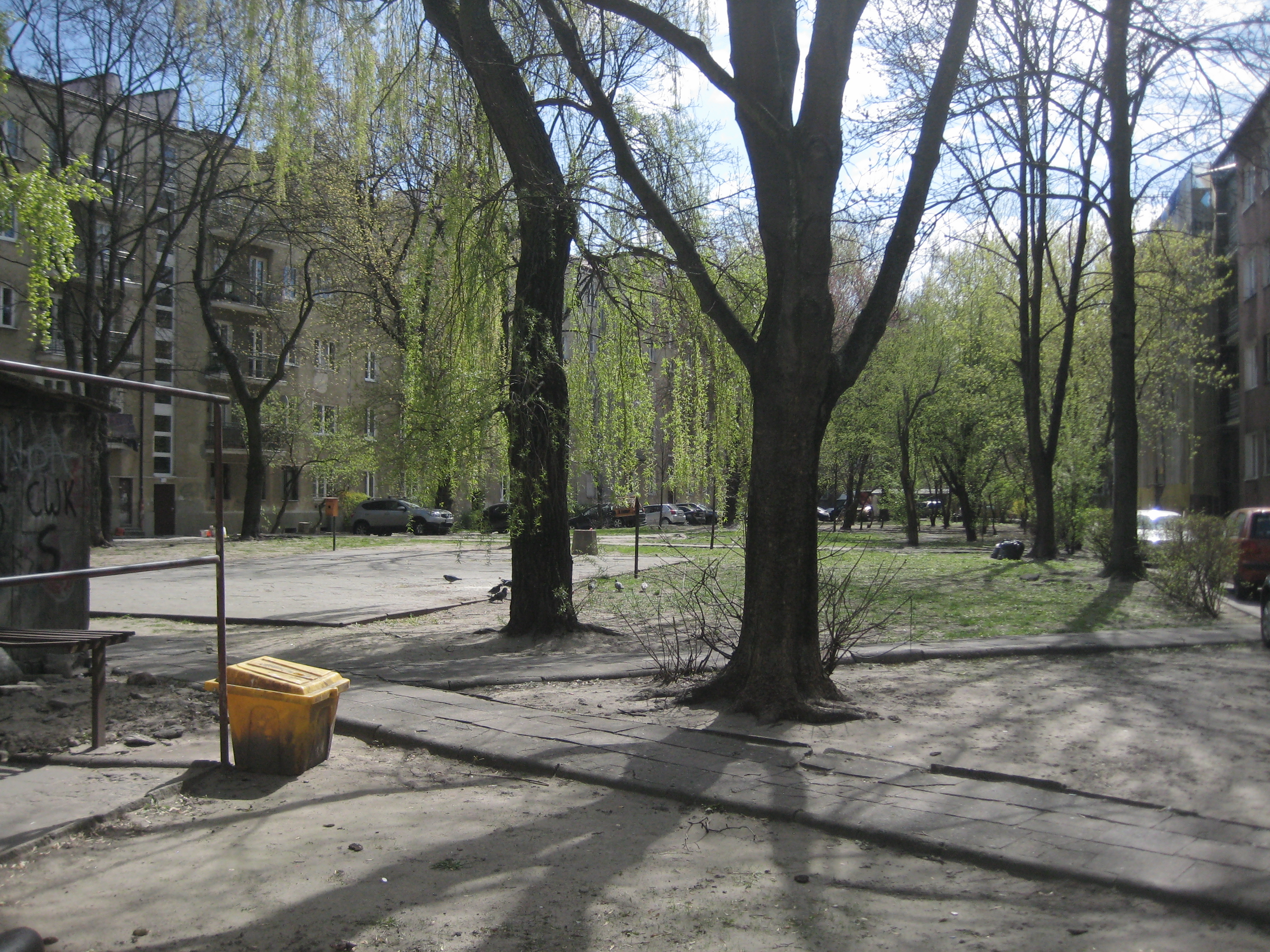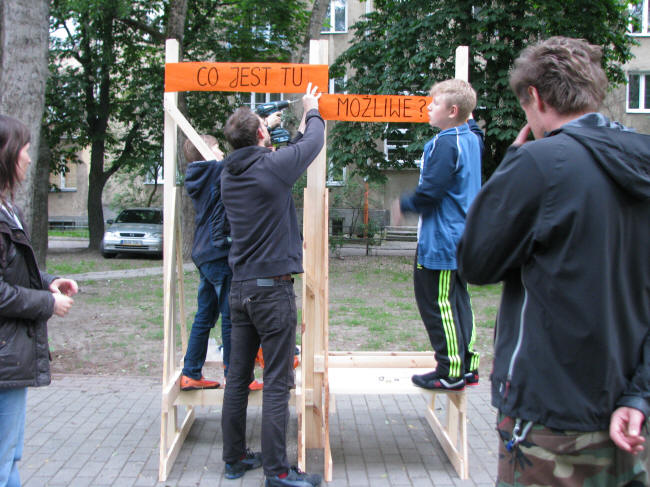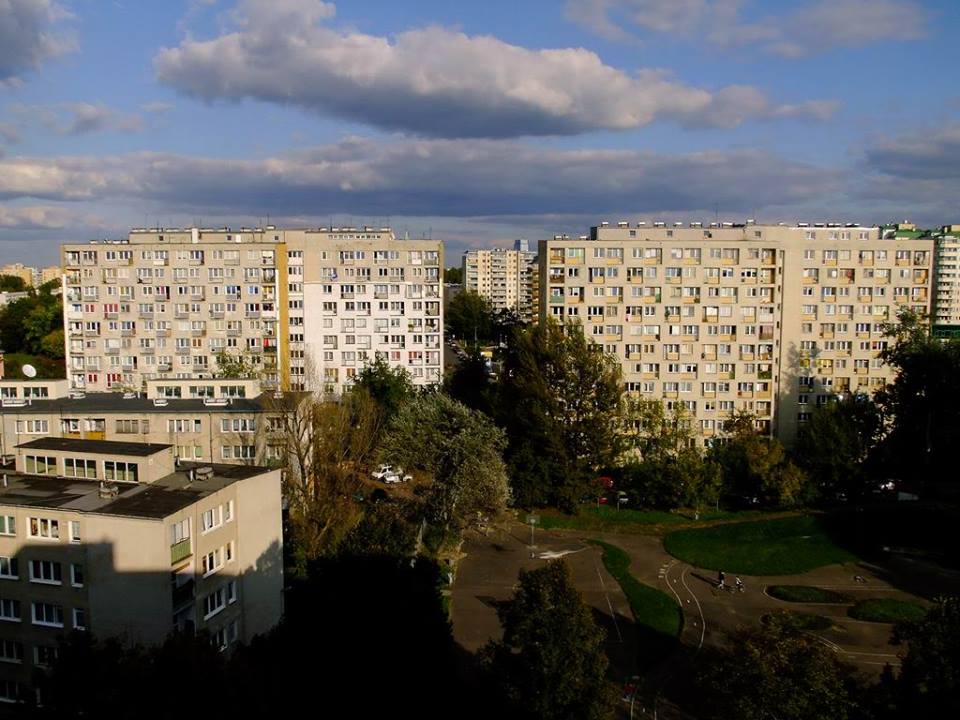|

Way-Marking Młynów
Artist Residency in Warszawa Poland April -June 2015
As
part of the internationally organised (Spain, UK, Poland) research
project 'Residency' Nina Scholz together with Tim Mitchell of
Plattformer were invited by IKP of Warsaw University and the local
partnership (N)GO ‘Młyn na Woli’ to spent two months in an area in the
district Młynów locally known as ‚Gibalak‘ with a reputation of social
problems, poverty, drug dealing and general neglect by the authorities.
In Collaboration with our hosts and cultural animator Agnieszka Dragon
we realised a series of participatory construction workshops and public
events within a backyard of Młynów. Our aim being to collect and present
personal stories and dreams and offer the possibility for a new point of
view and positive change. During the process of the residency the links
between ‚Młyn na Woli‘ and the inhabitants strengthened and a year after
in 2016 the participatory budget (city fund for local proposals by
inhabitants of a district) was won for infrastructural improvements to
the backyard.

Read about the project on
'publicystyka.ngo.pl'

Intro
from the Residency Blog:
"The
Polish residency was located in Młynów, a subdistrict of the Wola
district of Warsaw – the capital city of Poland. The residency was
hosted by local Partnership “Młynów na Woli” (Mill in the Wola
district). The population of Wola is estimated to be about 140,000. Wola
was a typical industrial area of the city before and during World War
II. Nowadays, Wola is developing rapidly and at the same time it remains
a district of many contrasts.
The
Partnership “Młynów na Woli” is an initiative involving local government
institutions,non-government organisations such as e.g. Polish Scouting
Association Warsaw Wola, Social Welfare Centre Wola District Capital
City Warsaw, Association Office of Social Initiatives “BORIS”,
Association of Education and Social Animation Praga Północ, Primary
School No. 166 “Z´ wirki and Wigury”, Common Children’s Cultural Centre
“Swietliki”, Municipality Office of the Wola District in Warsaw and
residents of the district. The aim of the Partnership is work for the
benefit of the residents of the area between Okopowa, Leszno,
Tyszkiewicza and Młynarska streets and to provide them with support in
dealing with neighbourhood problems and starting new local initiatives.
The
artist chosen for the residency by the “Młyn na Woli” Partnership and
the Institute of Polish Culture was Nina Scholz from the Plattformer
collective. Plattformer is a British based, not-for-profit group,
founded by Carl Richardson, Tim Mitchell and Nina Scholz. It is an
umbrella organisation of artists, architects and designer makers who
have been working together on projects in the public realm since 2004.
In the past they have worked with the London Borough Councils of Hackney
and Islington, the Building Exploratory, Breeze Landscape Architects,
Remapp Landscape Architects, St Mary Magdalene Academy and the general
public.
Nina
Scholz started her residency by meeting different groups of residents
from various clubs or activity centres as well as people met on the
streets. She, together with Tim Mitchell, another member of the
Plattformer, began collecting local knowledge from different age groups:
children from Kids’ Club “Swietliki”, adults from the Gibalskiego street
and seniors from the “Gold Autumn” club.
The
constant themes of these different talks focussed on the understanding
and use of the public space, the history and stereotypes of this part of
Wola and also the circumstances that influence the civic engagement and
cooperation of the residents. Starting from these initial interactions,
Plattformer focused their activities on creating friendly, comfortable
spaces, that can be “public” in a real sense; providing circumstances
for meetings of different kind of residents and ways to share individual
and varied opinions and stories.
One
of the important topics for the Plattformer was how to challenge the
stereotypical view of the neighbourhood. During the first few weeks of
the residency they initiated a few meetings with residents and
passersby. They focused on the construction of an installation that
resembled stairs, but it demanded an action from the user in order for
them to be defined. The stairs were used by the residents to sit, to go
up and see the yard from a different view point and even to practice
acrobatics and to take photos.
The
next part of the residency was focused on the Gibalskiego/Okopowa yard
and was aimed at common reflection on the imaginary inside and outside
space of this area. The inside space being the yard itself and the
outside referring to the place the residents were born, where they spend
free time or which provoke strong memories. Plattformer collected
different stories about the use of outside spaces by the residents. They
built a special installation called Stacja Nadawcza (Transmitter
Station), on which they attached the handwritten local stories in order
to make them visible within the space of the yard. While building the
construction and collecting the stories they also asked the most
important question connected with future action and change: what is
possible here?
During all different discussions in the yard, where some people
expressed their expectations towards both local government and their
neighbours, it occurred that, what is possible is a deal, is a barter,
where everybody is giving something on the conditions that there will be
an exchange. The logic of a “barter”, are close to the concepts of the
Everyday Urbanism, and
this
served as a theme for one of the next actions in the yard called
“something for something”. So the team of the residency proposed the
residents organised the common feast in the yard. They offered different
kind of plants, which residents could take home on the condition that
they promised to bring something or somebody for the feast: food, a
chair, an idea for activity, another plant or a neighbour. More than 50
exchanges took place in the yard and next week Podwórkówka (the yard
feast) was full of participating people, the table was full of food and
many people enjoyed the fact that everybody took a part in organising
one of the first common gatherings in this yard.
The
constructions built by the Plattformer were important parts of many
different activities organised together with residents and members of
the Partnership. “Not Paris, not Rome, not Praha or Bratislava. Only
here, where we have the Vistula river, Warsaw, Wola and its Mill. Here
is a nice yard. Here you can hear the neighbours’ voices, here many
things can be done and can happen, despite frost or heat. The youngest
generation will start and the adults will slowly join them. We invite
everybody to improve the state of our yard. It will happen, because we
have great neighbours.” Mrs Ela, neighbour from Gibalskiego "
Further information:
www.facebook.com/pg/residency/posts/
www.facebook.com/mlynnawoli/
www.facebook.com/events/1531327157149823/
|